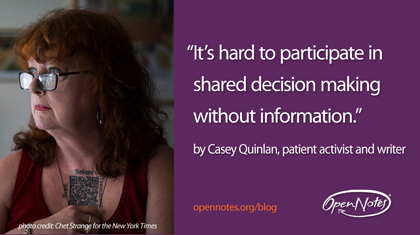
by Casey Quinlan, the “Mighty Mouth” of Mighty Casey Media LLC
RICHMOND, VA – Culture change requires … culture change. Shifting one person’s thinking about an issue is a heavy lift. Doing that with a group, particularly a highly educated group used to being the smartest people in the room? That can be a monumental lift. No one involved with the OpenNotes movement is surprised by that observation – we live that truth every day.
One of the signals that shift is happening is the rise in public discussion of people/patient’s access, in real time, to the clinician notes reporting on tests and scans that are part of their treatment.
I have myself, both as a family caregiver and as a cancer patient, had to push for real-time access to these lab results and imaging reports. My father’s neurologists and orthopedist learned to have reports ready for us when I took my dad to clinic visits as I helped him manage his advancing Parkinson’s disease and osteoarthritis. I’ve made a rule of getting mammograms only at practices where the doctor and patient view the films and discuss the findings together as part of the clinic visit, which made a huge difference in my health literacy, and in my activation and engagement, even before my breast cancer diagnosis.
(By the way, I was the first person to point out the tumor on the mammogram that revealed my cancer. I pointed, asked, “what’s that?” and we were off on a Cancer Year adventure.)
It’s hard to participate in shared decision making without information!
Seeing the notes from each clinic visit, as well as reports on imaging and lab results, in real time gives people/patients the information they need to understand and participate in their health and their health care and to make truly informed decisions. It also gives patients the chance to spot inaccuracies in their notes and records and the opportunity to have those inaccuracies corrected. “Nothing about me without me” – including clinical notes and reports – is where OpenNotes can drive exponential system transformation. By encouraging clinical teams to advocate for real-time notes and records access, they can also drive literacy-building programs within their professional societies that help patients understand the reports in their patient portals.
Participation in health and health care is a right and a responsibility.
The only way people can participate as fully as possible is if they – WE – are given the information we need to do that. So I became an “e-patient.”
If you’re wondering what an “e-patient” is, it’s defined as someone who is:
- Enabled and encouraged by their clinical team to participate in care;
- Equipped with the information they need to fully participate;
- Empowered by the information they acquire and share;
- Engaged and fully participating in all aspects of their care and its management; and
- seen as a fully Equal partner in their care and all treatment decisions.
Which is why I’m a passionate supporter of OpenNotes and in real-time reports being made available on patient portals.
There was a robust discussion recently in the e-patient community about a set of articles in the Journal of the American College of Radiology (JACR) that took a point/counterpoint approach to the idea of patients having direct access to the notes or reports radiologists write after interpreting images.
(E-patients are all about OpenNotes, too, in case you were wondering.)
The patient POV, written by Andrea Borondy Kitts, MPH, an editor at JACR who is also a lung cancer research advocate, said, “The right way to provide these reports to patients will vary by the specific imaging test situation and by patient preference. I propose that patients be able to select their desired methods of receiving both images and radiologists’ reports at the time their tests are ordered.”
The opposing view, from radiologist Andre Konski, MD, held that, in order to prevent unnecessary distress over information contained in those reports, patients should be given access to reports only when in consultation with their doctor. He shared anecdotes from his own clinic: One, where a friend called him in a panic after seeing mention of lung nodules in a report about a bowel scan; another where Konski noted he had to calm down a patient at least once a year over radiology reports related to his cancer treatment.
Let’s keep this conversation going. Read both sides of the discussion and let me know what you think.
You already know where I stand. Trust people to be savvy enough to ask questions. Help them understand what they need to know to fully participate. Lather, rinse, repeat – because we’re all in this together.
Casey Quinlan is a writer, journalist, and health policy wonk. She is a supporter of the OpenNotes movement, and blogs at MightyCasey.com. Follower her on Twitter at @MightyCasey.



